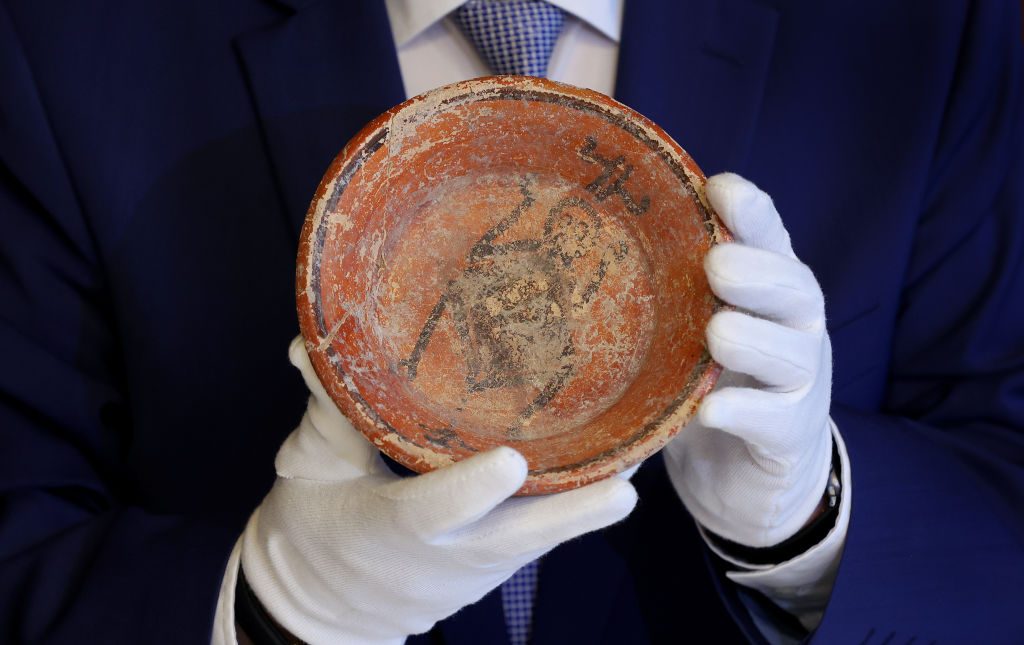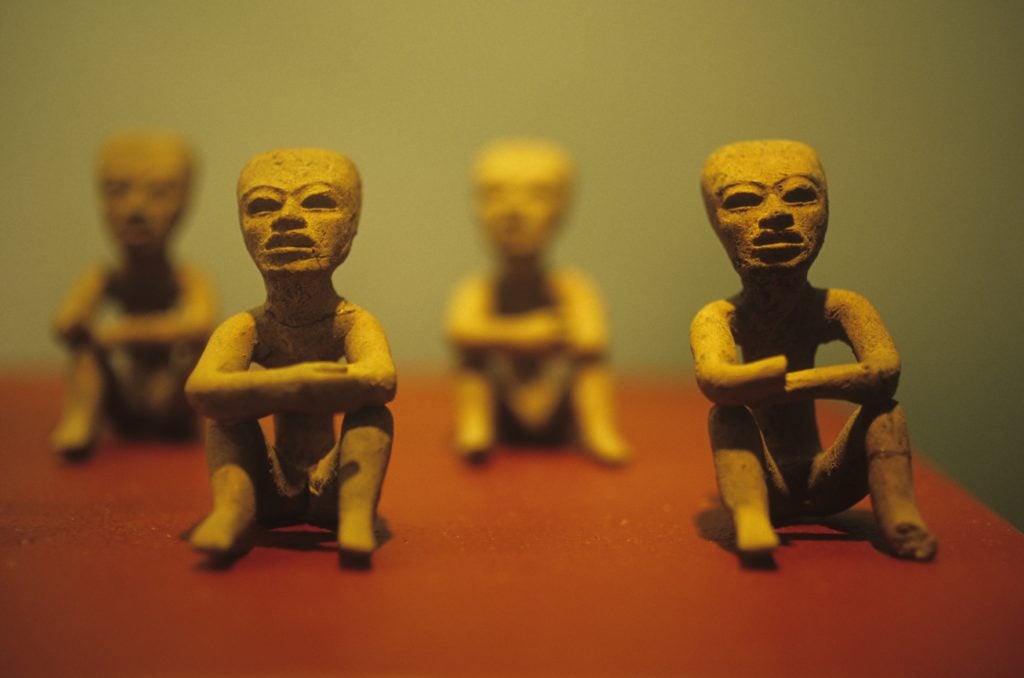Archaeology & History
Mexico Is Ramping Up Its Efforts to Repatriate Its Lost Pre-Columbian Heritage—Spelling Trouble for the Market and Museums
Politicians and activists are campaigning for the repatriation of these sacred cultural objects.

Politicians and activists are campaigning for the repatriation of these sacred cultural objects.

by
Amah-Rose Abrams

News last month that Citibanamex, Citigroup’s Mexican retail banking arm, would sell its art collection along with the bank prompted the country’s highest official to speak out.
While for some nations art and cultural objects might not be a primary concern upon the sale of a major national bank, the 2,000 artworks whose fates hang in the balance constitute a significant survey of Mexican art history, and for Mexico, preserving cultural heritage is a national priority. Since Mexico’s president Andres Manuel Lopez Obrador took office in 2018, his administration has been vocal about its desire to repatriate ancient cultural heritage and nearly 6,000 pieces have been returned to Mexico so far.
This policy has been making headlines in the art world as officials have intervened to attempt to block sales of ancient cultural objects from Mexico abroad. The “discovery” and “collection” of these items came after Columbus’s arrival in South America in the fifteenth century—hence the widely used term “Pre-Columbian.”
Culture minister Alejandra Frausto Guerrero has been outspoken about her stance that the nation’s heritage “is not for sale,” and has stepped in on four auctions over the last three years in New York, Paris, Munich, and Rome. The minister last year told AFP ahead of two auctions in France of pre-Hispanic pieces that Mexican law decrees that “any piece of national heritage that is permanently outside the country, not temporarily for an exhibition or cultural cooperation, comes from an illegal act.” Her efforts finally paid off when a sale in Rome was successfully halted last September, taking 17 Mesoamerican artifacts off the market, in line with Italy’s policy on looted artifacts.

Pre-Columbian sculpture, Museo Amparo in Puebla, Mexico in 2011. Photo by Veronique DURRUTY/Gamma-Rapho via Getty Images.
The roots of these moves at an international level lie in both activism and academia. Elizabeth Baquedano of University College London’s Institute of Archaeology told Artnet News that she believes the sale of these objects at auction should be stopped altogether. For archaeologists, these ancient objects break the chain of history when physically removed from their context. For those concerned with the cultural heritage of Mesoamerica, some sacred items lose their meaning when placed in certain museum contexts.
“Some masks are considered to be part of the ancestors; you wouldn’t be selling the bones of your ancestors so why would you be selling the masks of your ancestors?” Baquedano said. “It lacks respect for the unnamed ancestors who produced them.” The academic believes that replica objects often sold as souvenirs or fakes masquerading as the real thing can be produced to such a high standard that there is no need for private individuals to own the originals as art objects.
“Luckily, I think we’re all moving towards a more just situation,” Baquedano said. ”In the sense of respecting cultures, the heritage of a people, and the individuals themselves that produced them; people who had a very different take on the meaning of these objects than the auction houses are giving them.”
As the profile of the conversation about repatriating Mesoamerican heritage rises, the marketplace for these objects is finding difficulty. Christie’s “Pre-Columbian Art & Taíno Masterworks” auction last November was preceded by an in-person protest, noise in the press, and a petition signed by 57,691 supporters trying to halt the sale. Official representatives from several countries in Central America published a joint statement expressing “concern about the commercialization of cultural property” and a “strong rejection” of the sale due to “the devastation of the history and identity of the peoples involved in the illicit trade of cultural property.” The auction went ahead but a third of the lots went unsold.
Some collectors have begun voluntarily surrendering objects of cultural significance. French collectors Manichak and Jean Aurance returned a Maya stone carving they had planned to sell at auction to Guatemala in October last year after they discovered it had been looted.
While the attitude surrounding sacred ancient objects and their cultures of origin is changing, desire for these unique items remains strong. Auctions of these items and antiques from Africa and Oceana take place regularly at the major auction houses; Bonham’s New York recently sent out an open invitation for a two-day complimentary valuation and consignment session, advertising the high prices these items can fetch.
According to Fredric Backlar, director of African, Oceanic and Pre-Columbian art at Bonhams, strong provenance is more important than ever. “The market for top quality works has grown due to the limited supply of the material, crossover collectors from other collecting categories, as well as the legal parameters associated with ownership,” he said. “Artworks which have iron-clad documentation and provenance are highly regarded and command higher prices than those lacking documentation.”

Mask, (300–600). Photo © Dumbarton Oaks, Pre-Columbian Collection, Washington, DC. Image courtesy of the Fine Arts Museums of San Francisco.
Mexico has been making efforts to reclaim lost heritage since the fall of the dictator Porfirio Díaz in 1911. Mexico embraced its Indigenous heritage post-revolution and the government celebrated the country’s pre-colonial history by commissioning art, most famously Diego Rivera’s world-famous mural Carnival of Mexican Life. Dictatorship (1936). Rivera collected Mesoamerican and Pre-Columbian artifacts himself, and Rivera’s collection is now housed in the Anahuacalli Museum in Mexico City which the artist designed and was fully realized in 2021.
In recent years, the conversation has grown in tandem with international awareness of Indigenous cultures thanks to activist groups putting pressure on public institutions to return heritage taken during the colonial era—with the most attention focused on African nations—and calls to increase scholarship on pre-colonial histories more generally. This includes drawing attention to the fact that while some Indigenous peoples are considered to have been wiped out this is not always the case.
“There has been a myth that we need to rectify, the ‘disappearance narrative’ for Indigenous Caribbeans,” Laura Osorio Sunnucks, the British Museum’s head of the Santo Domingo Centre of Excellence for Latin American Research Africa, Oceania and the Americas, told Artnet News.
“I’m talking here about Mesoamerica but all of these boundaries have been contested, because boundaries in the sense of the nation state and the way we understand it didn’t exist when these objects were made,” Osorio Sunnucks explained, adding that although the Caribbean is not considered Mesoamerica, the Taíno people have a connection to the people of the Yucatan Peninsula in Mexico which is both Mesoamerican and Caribbean. It’s complicated, and the conversation around the heritage of these ancient artifacts is in flux as a result.
As auction houses continue to actively source these artifacts for regular sales, some believe that the trade in such objects is so entrenched in Western culture that to stop it entirely seems a long way off. But the progress in conversations surrounding the restitution of African heritage in recent years has been encouraging, and as Mexico joins forces with countries across Central, South America and the Caribbean, all looking educate people about their Indigenous heritage and populations, it could be on the cusp of reversing the tide of objects that are a part of that history from leaving the country.